Introduction
Africa is home to the only two species of gorilla in the world: the Eastern and Western gorilla. Uganda’s majestic mountain gorilla (Gorilla beringei beringei) is a subspecies of the Eastern gorilla.
Uganda’s remaining gorillas can be found in just two places: on the Virunga Mountain slopes in Mgahinga National Park and in Bwindi Impenetrable Forest National Park. As their name suggests, mountain gorillas can be found enjoying the views from the mountains, at elevations between 1,400 and 3,800 metres.1https://ugandawildlife.org/animals/mountain-gorilla/
Tragically, mountain gorillas are a highly endangered species, although thanks to the around-the-clock protection of the Park Rangers of Bwindi, are no longer critically endangered.2https://www.worldwildlife.org/species/gorilla Still, according to the most recent gorilla survey, only 1063 mountain gorillas remain on the planet and at least 459 of these reside in Uganda’s Bwindi Impenetrable Forest.3https://igcp.org/content/uploads/2020/09/Bwindi-Sarambwe-2018-Final-Report-2019_12_16.pdf That means nearly half of all mountain gorillas live in Bwindi so it is imperative we protect the forest!
Fascinating facts
Family comes first with mountain gorillas
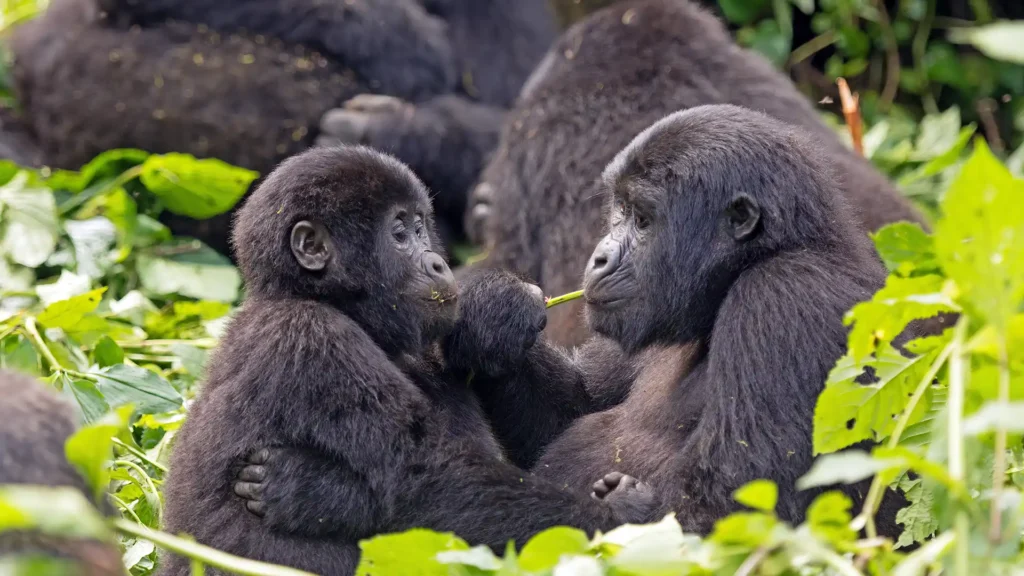
Most gorillas live in close families – or troops – of 10 to 30 members, with one dominant male and several females. Males and females both help look after their infants, playing with them and making sure they are safe. When they grow up, most males and around 60 per cent of the females leave home to join another family.4https://www.wwf.org.uk/learn/fascinating-facts/gorillas
Baby gorillas are called infants (just like us!)
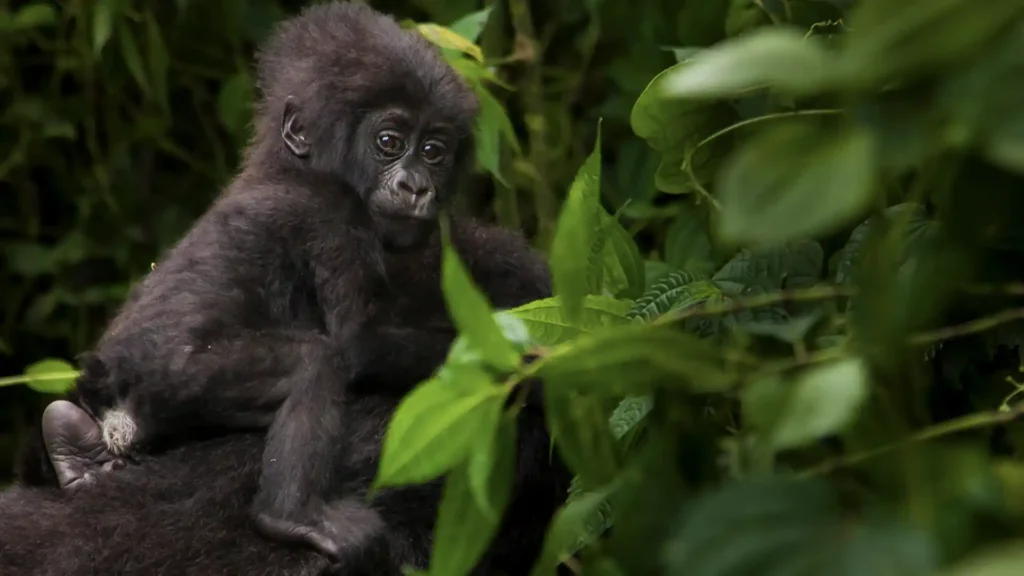
Gorillas are considered grown-ups at just eight years old. Between eight and 12 years old, male gorillas are called ‘blackbacks’ until they become ‘silverbacks’, because of – you guessed it! – the metallic silver hair on their backs.4https://www.wwf.org.uk/learn/fascinating-facts/gorillas Gorillas live up to 40 years in the wild but the oldest gorilla in the world is 66 (as of 2023).
The love of a mother is like no other
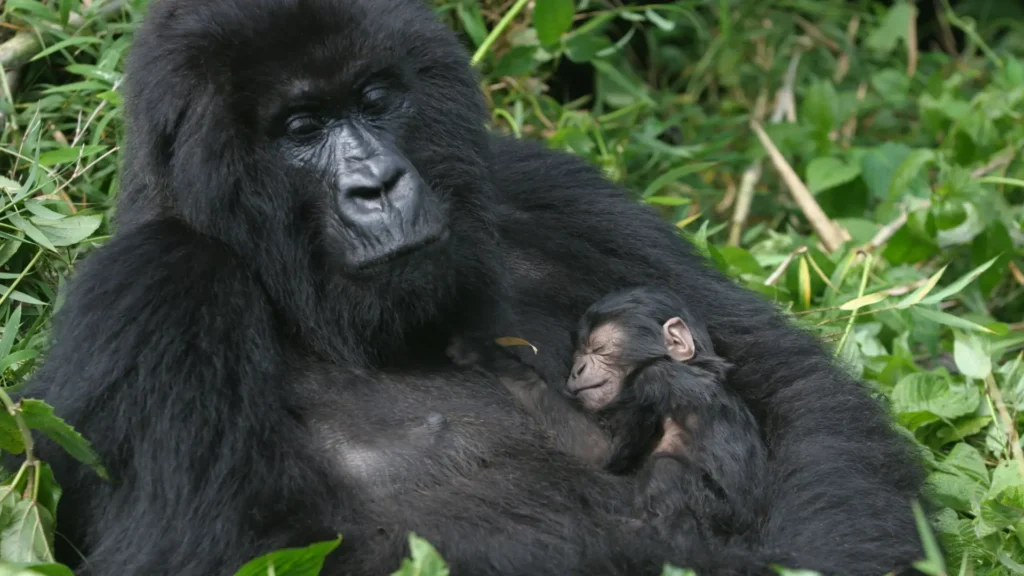
Just like humans, a mother gorilla gives birth to one infant after a nine-month pregnancy. Although gorillas grow much bigger and stronger than us, their babies are tiny. At birth they only weigh 1.8 kilograms (four pounds) but are already able to cling to their mother’s fur as she gently clutches them to her chest. Once they reach four months old, they are strong enough to ride around on their mother’s back, which they’ll do until they are weaned at around three years old.5https://www.nationalgeographic.com/animals/mammals/facts/mountain-gorilla A mother gorilla is totally devoted to her child and their bond lasts a lifetime.6https://gorillafund.org/uncategorized/gorilla-moms-and-dads-being-together/
Gorillas like a fresh bed!
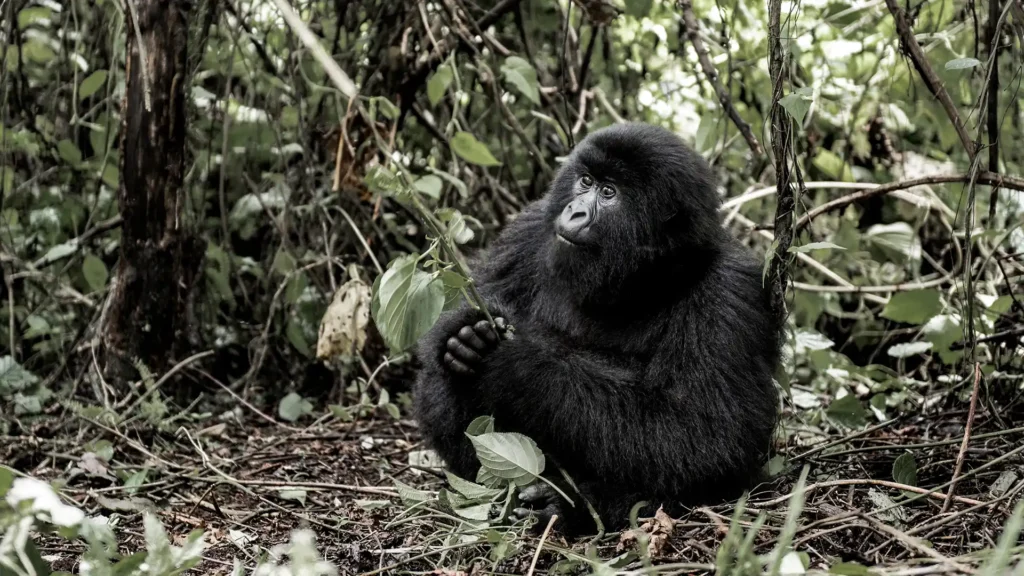
Every night gorillas make a new nest, on the ground or in the trees (if they’re light enough!), out of leaves, branches and bushes. Being a gorilla is tiring so they sleep for 12 hours a night!7https://gorillafund.org/uncategorized/gorilla-night-routines/ Mother gorillas sleep with their infant until they are three years old, and if the infant has sadly been separated from his or her mother, the silverback will take the infant into his nest to keep them warm during the cold mountain nights. One silverback called Isabukuru, looked after three infants, and another silverback, Bwenge, took care of two. When Isabukuru sadly died, Kubaha took over, continuing to be surrounded by infants day and night.6https://gorillafund.org/uncategorized/gorilla-moms-and-dads-being-together/
Infant gorillas play just like human children
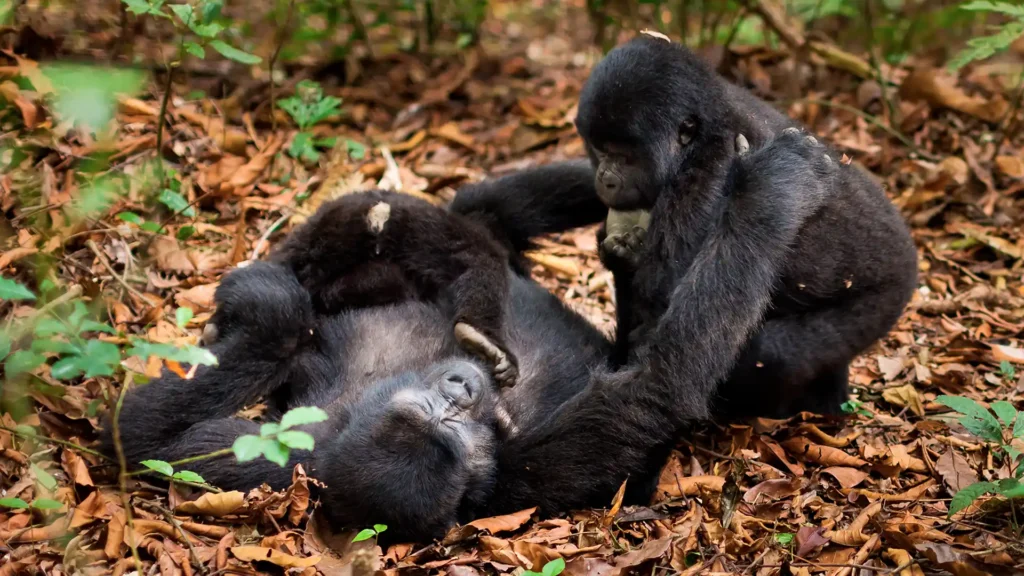
Just like young humans, young gorillas between three and six years old are very playful and mischievous. They can be seen playing with and chasing each other, climbing trees and swinging from branches. The jungle is their playground, and they love to make the most of every branch, vine and liana!
Silverbacks would be record-breaking weightlifters!

An average silverback weighs 195 kg (almost 31 stone) and is 1.5 metres (almost 5 feet) tall. Silverbacks are incredibly strong and can lift over 800 kg (126 stone) – without ever going to the gym! The human record for the deadlift is just over 500 kg (78.7 stone) but most people won’t come anywhere close.8https://virunga.org/wildlife/primates/mountain-gorillas/silverback-gorilla/ Although silverbacks are one of the strongest mammals on Earth, their real strength lies in maintaining a peaceful and prosperous troop.
Mountain gorillas love plant-based food!

Gorillas are herbivores and spend about six hours a day eating to get all the energy they need – that’s about 30 kilograms of plants!9https://www.natgeokids.com/uk/discover/animals/general-animals/gorilla-facts/ Leaves, shoots and stems make up about 86 per cent of their diet and they are known to eat 142 different plant species. Seven per cent of their diet is made up of roots, three per cent flowers and two per cent fruits.10https://www.gorillaugandasafaris.com/blog/mountain-gorilla-diet/ The remaining two per cent includes snacking on a tiny amount of insects and even rotting wood for the minerals it contains!4https://www.wwf.org.uk/learn/fascinating-facts/gorillas
Mountain gorillas are organic farmers
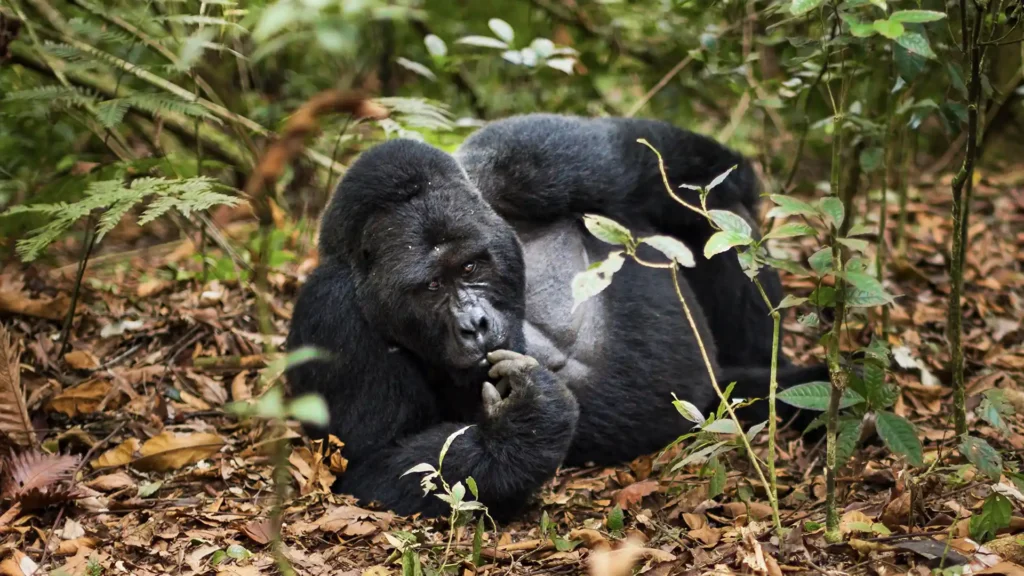
Mountain gorillas play an important part in maintaining a healthy ecosystem. Not only do they help clear the land so sunlight can penetrate the thick forest foliage and help new plants grow, but they also disperse seeds from the fruit they eat. When they go to the toilet, they are effectively planting these seeds in a big pile of organic fertiliser so that they can grow into new plants and trees.11https://www.ifaw.org/uk/animals/mountain-gorillas
Mountain gorillas have many forms of communication

Gorillas talk to each other using sounds and actions. Some sounds are high-pitched and playful so they can express alarm or curiosity, while others are fierce and powerful to scare off threats and rivals.4https://www.wwf.org.uk/learn/fascinating-facts/gorillas Gorillas use ‘grumbles’ to share their location with others and even to comfort each other. Mountain gorillas are also intelligent enough to read very subtle expressions in their family members’ eyes and visual cues are often used in a troop.12https://www.clevelandzoosociety.org/z/2022/03/04/ask-the-expert-how-do-gorillas-communicate In captivity, gorillas have even been taught basic sign language. Koko was the most famous gorilla to learn sign language. She was able to mimic complex gestures, and understand that if she made certain signs, she’d get a banana.
Mischief monkeys!

Gorillas (like bonobos, common chimpanzees and orangutans) have a sense of humour! They tickle and poke each other for fun. They also steal from each other just to playfully tease. This mischievous behaviour shows how cognitively advanced the great apes are. They also all laugh when they are tickled, or when they wrestle and play chase.13https://www.livescience.com/60864-do-animals-have-humor.html 14https://www.newscientist.com/article/2417005-great-apes-like-teasing-each-other-which-may-be-the-origin-of-humour/
Gorillas are engineers
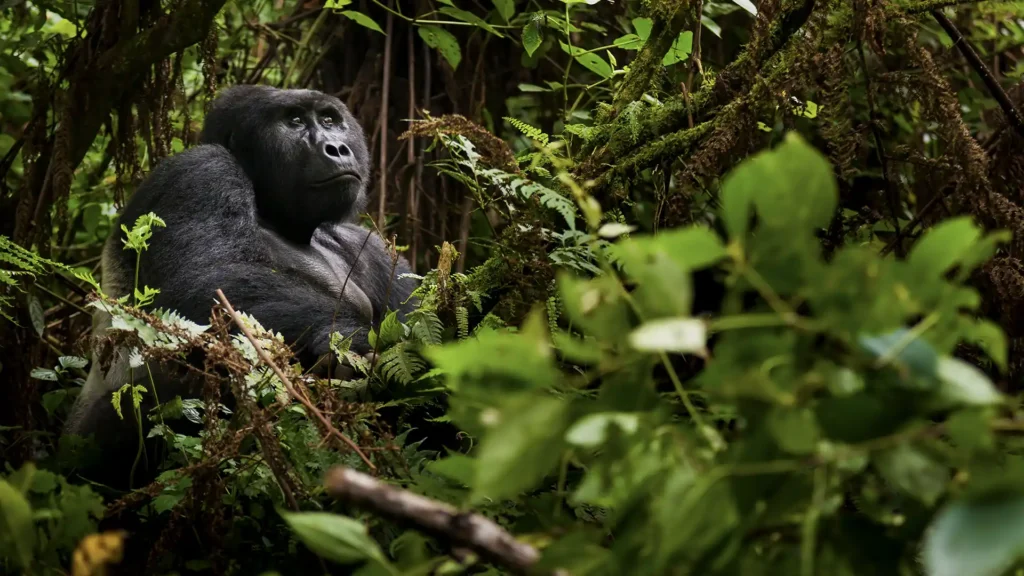
You’ve probably heard of chimpanzees and gorillas using twigs like cutlery to scoop up little insects or dig ants out of their nest, but that’s just scratching the surface of what a gorilla can do with tools. Scientists have witnessed mountain gorillas creating ladders from bamboo so their infants can reach the higher branches of trees and using sticks to calculate the depth of rivers and streams.15https://www.sciencedirect.com/science/article/abs/pii/S0376635713002052 So, gorillas have both brains and brawn!
Mountain gorillas are our second closest relative
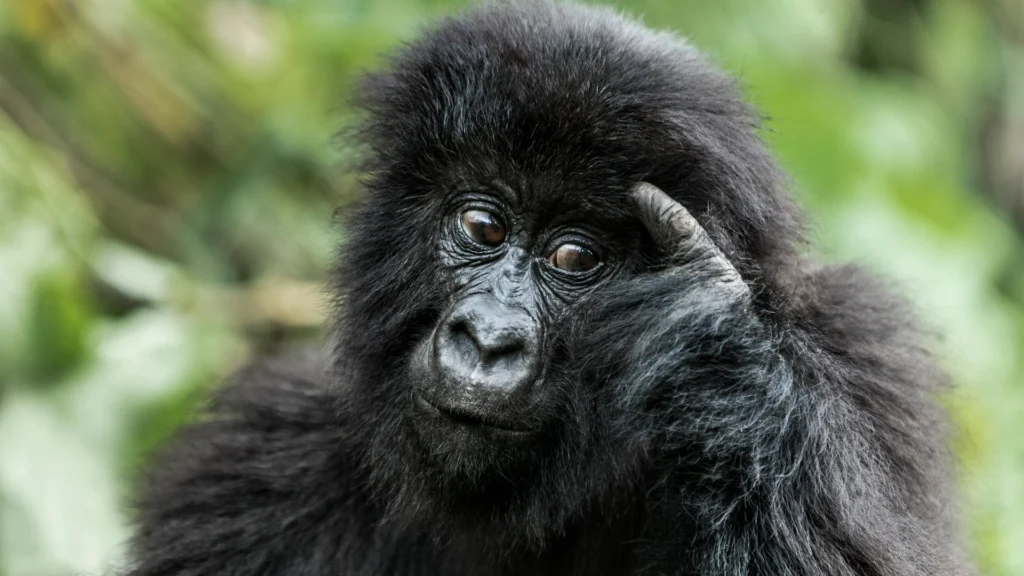
After chimpanzees, mountain gorillas are the second most-related ape to humans. Humans and gorillas share about 98 per cent of the same DNA.16https://www.scientificamerican.com/article/tiny-genetic-differences-between-humans-and-other-primates-pervade-the-genome/ and mountain gorillas may be even more closely related to humans than we think. For example, scientists recently discovered that humans and gorillas share a very similar ear shape.17https://www.nature.com/articles/nature10842
Threats to mountain gorillas
Habitat loss

The main cause of habitat loss is deforestation to turn the forests into farmland.4https://www.wwf.org.uk/learn/fascinating-facts/gorillas 18https://igcp.org/mountain-gorillas/threats/ The trees are hacked down and replaced with crops to feed the growing human population. Smallholder cattle is also encroaching into protected areas. The forest is also damaged and degraded when people illegally cut down the trees to use as firewood. Although these actions are driven mainly by poverty and desperation, there is no regard for the well-being of the wildlife that lives there.
The forests in which the mountain gorillas live are already surrounded by farms and settlements but as the human population around Bwindi grows, humans are encroaching more and more into the gorillas’ territory. If this continues the gorillas won’t have enough space to live. Because gorillas are so big, they need to eat a lot of plants to stay strong. Once they’ve eaten all the plants in one area, they’ll move on to another spot and let the old patches grow back. But as more and more of the surrounding land is invaded by humans, the gorillas don’t have enough space to do this and begin starving to death. So, out of desperation, they explore farmland to find food, where they could encounter human diseases and other hazards.
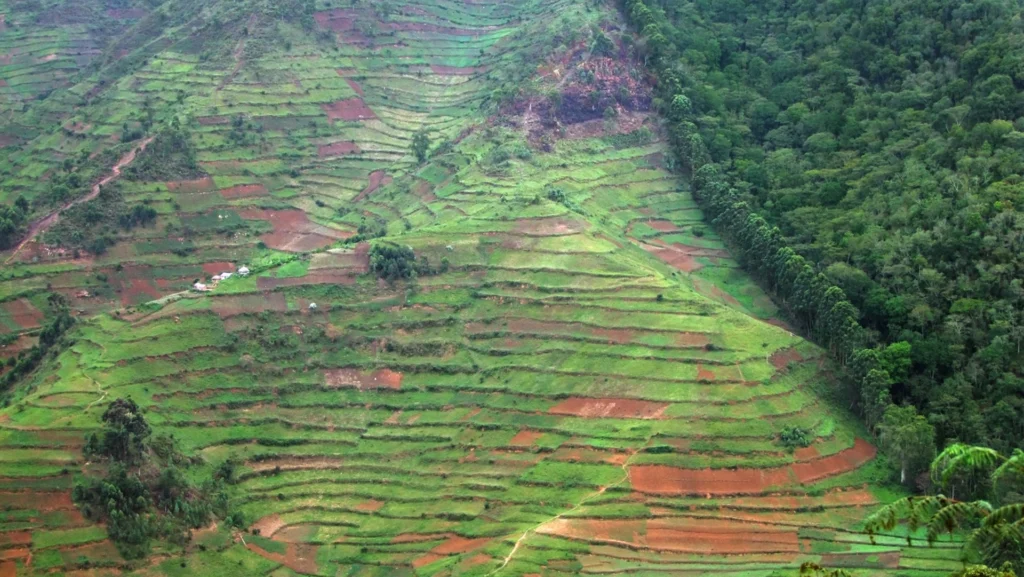
Disease
Because mountain gorillas are genetically 98 per cent the same as humans, illnesses can easily be passed between us and them. However, gorillas have never developed immunity to many of our illnesses so a common cold might be harmless to us but could be deadly for them. If a virus was to pass through a family of gorillas, it could have devastating consequences, killing both babies and older gorillas. Ebola hemorrhagic fever is one of the most harmful human diseases threatening the mountain gorillas. It is often fatal and has killed thousands of gorillas in the past.11https://www.ifaw.org/uk/animals/mountain-gorillas The more that humans enter the gorillas’ habitat, the more vulnerable to illness and disease the gorillas become.
Poaching

In the 20 years following the discovery of the mountain gorilla in 1902, dozens were brutally killed both by scientists for research and by trophy hunters. In the 1960s and 70s, poachers would make a lot of money by selling gorillas to foreigners as trophies and even captive prisoners for private collectors and zoos.18https://igcp.org/mountain-gorillas/threats/ A whole family of gorillas would have been slaughtered just so an infant could be captured for a zoo.
Poaching is rarer these days, thanks to the dedicated protection of the Rangers of Bwindi, but still continues to threaten Uganda’s gorillas. To some rich people, ape meat is seen as a sign of wealth11https://www.ifaw.org/uk/animals/mountain-gorillas so gorillas are under constant threat. In 2020, Rafiki, one of Uganda’s rare silverback mountain gorillas was killed by four poachers who snuck into Bwindi Impenetrable Forest with spears.19https://www.bbc.com/news/world-africa-53024073 The cruel killer of the 25 year old silverback was sentenced to 11 years in jail.20https://www.nytimes.com/2020/07/30/world/europe/poacher-gorilla-rafiki-silverback-uganda-prison.html If no one was protecting the gorillas, there is no doubt they would be poached to extinction.
However, it’s more likely that they’ll fall victim to illegal snares set up to catch other animals for food, such as antelopes and bush pigs. If a gorilla accidentally gets caught in a snare, they will be seriously injured or killed, often left struggling to free themselves as the snare cuts deeper into their arm or leg18https://igcp.org/mountain-gorillas/threats/ Rangers and trackers are constantly trekking through the jungle, searching out and dismantling the snares to protect the gorillas. And even the gorillas are intelligent and determined enough not to take this lying down. In 2012, a poor infant gorilla in Rwanda was cruelly killed in a ‘rope-and-branch’ snare, after suffering from a dislocated shoulder and gangrene where the snare had cut her leg. But just a few days later, her heroic four-year-old brother and sister, Rwema and Dukore, were seen bravely dismantling snares so that their loved ones would be safe. Infant gorillas have seen so many snares injure and kill their family members that they have learnt how to destroy them.21https://www.nationalgeographic.com/animals/article/120719-young-gorillas-juvenile-traps-snares-rwanda-science-fossey This shows an overwhelming concern for their loved ones, as well as intelligence and bravery to be admired.
Climate change
Gorillas are hardy and adaptable animals but even they can’t escape the effects of climate change. Changes in rainfall patterns and temperatures can affect the food they rely on, lead to thermal stress and make them more likely to get sick. In times of drought, forest fires have the potential to kill the gorillas and destroy their habitat.22https://gorillafund.org/uncategorized/climate-change-mean-gorillas/ But, it’s actually the effect that climate change has on the local people that may be the largest threat to Bwindi’s mountain gorillas. For example, if droughts cause crops to fail and reduce water availability, humans will have to look to the forest for food and water. This could mean more illegal hunting of wildlife leading to injury and death for the gorillas, as well as an increased risk of spreading diseases to the gorillas as people spend more time in the forest.23https://www.worldwildlife.org/pages/mountain-gorillas-and-climate-change
Human conflict
As if poaching, climate change and habitat loss weren’t enough, mountain gorillas have also had to contend with violent human conflicts. Most of the human conflicts affecting mountain gorillas have taken place in the Democratic Republic of Congo (DRC) and in neighbouring Rwanda. Gorillas have been caught in the middle of fierce gunfights and been gunned down by AK-47s, and had their habitat destroyed by explosive warfare.11https://www.ifaw.org/uk/animals/mountain-gorillas Because of Uganda’s relative stability, it has the best chance of becoming a haven for mountain gorillas, if we support it.
The role of responsible tourism
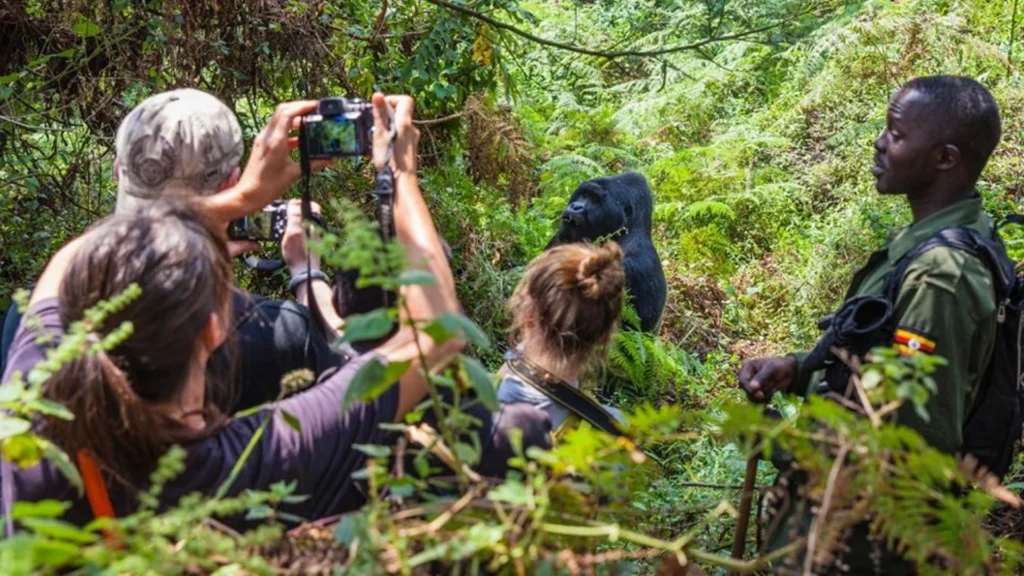
Responsible community tourism has a huge part to play in ensuring the mountain gorillas of Bwindi continue to thrive. The vast majority of money from tourism goes directly to protecting Bwindi’s mountain gorillas by funding conservation efforts. This includes the 24/7 monitoring and protection of the gorillas by the Rangers of Bwindi, as well as funding community projects and resolving human-wildlife conflict. 24https://www.muchbetteradventures.com/magazine/mountain-gorillas-bwindi-impenetrable-forest/
One of the most important roles of tourism in Bwindi is funding community projects. A 2022 study25https://conbio.onlinelibrary.wiley.com/doi/10.1111/csp2.12761 of Bwindi found that illegal activities which threaten wildlife – such as logging and hunting – decrease when more long-term community projects are funded. Community-based tourism gives the local people of Bwindi an alternative source of income, so they no longer need to exploit the forest for resources.
When tourists visit Bwindi, not only do they want to see the gorillas, but they want to stay in local accommodation, eat traditional food and enjoy activities such as hiking and birdwatching. This provides employment opportunities for locals, improves infrastructure, and helps fund a more stable economy so they are less reliant on exploiting natural resources.
One of the aims of Viva! Uganda, through Gorilla Defenders, is to fund the brilliant volunteers of HUGO (Human Gorilla Community Organisation) who are trained in gorilla behaviour and who scout around Bwindi National Park and persuade the gorillas to move back into the forest when they move out of it. Viva! is funding various equipment from raingear to walkie talkies to tents to simple incentives to do the work. And an aim of Viva! Uganda’s Project Kindheart, is to teach the children of Uganda the value of its wildlife so that they understand the importance of protecting Bwindi Impenetrable Forest and its inhabitants. Then, when they grow up, they won’t view the forest as a resource to be exploited but a treasure to be revered, thus preventing future human-wildlife conflict and creating a conservation-minded community who can positively engage with community tourism.

What Viva! is Doing to Help
One of the aims of Viva! Uganda, through Gorilla Defenders, is to fund the brilliant volunteers of HUGO (Human Gorilla Community Organisation) who are trained in gorilla behaviour and who scout around Bwindi National Park and persuade the gorillas to move back into the forest when they move out of it. Viva! is funding various equipment from raingear to walkie talkies to tents to simple incentives to do the work. And an aim of Viva! Uganda’s Project Kindheart, is to teach the children of Uganda the value of its wildlife so that they understand the importance of protecting Bwindi Impenetrable Forest and its inhabitants. Then, when they grow up, they won’t view the forest as a resource to be exploited but a treasure to be revered, thus preventing future human-wildlife conflict and creating a conservation-minded community who can positively engage with community tourism.
References
References
- 1
- 2
- 3
- 4
- 5
- 6
- 7
- 8
- 9
- 10
- 11
- 12
- 13
- 14
- 15
- 16
- 17
- 18
- 19
- 20
- 21
- 22
- 23
- 24
- 25

